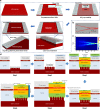Monolithic integration of embedded III-V lasers on SOI
- PMID: 37009809
- PMCID: PMC10068801
- DOI: 10.1038/s41377-023-01128-z
Monolithic integration of embedded III-V lasers on SOI
Abstract
Silicon photonic integration has gained great success in many application fields owing to the excellent optical device properties and complementary metal-oxide semiconductor (CMOS) compatibility. Realizing monolithic integration of III-V lasers and silicon photonic components on single silicon wafer is recognized as a long-standing obstacle for ultra-dense photonic integration, which can provide considerable economical, energy-efficient and foundry-scalable on-chip light sources, that has not been reported yet. Here, we demonstrate embedded InAs/GaAs quantum dot (QD) lasers directly grown on trenched silicon-on-insulator (SOI) substrate, enabling monolithic integration with butt-coupled silicon waveguides. By utilizing the patterned grating structures inside pre-defined SOI trenches and unique epitaxial method via hybrid molecular beam epitaxy (MBE), high-performance embedded InAs QD lasers with monolithically out-coupled silicon waveguide are achieved on such template. By resolving the epitaxy and fabrication challenges in such monolithic integrated architecture, embedded III-V lasers on SOI with continuous-wave lasing up to 85 °C are obtained. The maximum output power of 6.8 mW can be measured from the end tip of the butt-coupled silicon waveguides, with estimated coupling efficiency of approximately -6.7 dB. The results presented here provide a scalable and low-cost epitaxial method for the realization of on-chip light sources directly coupling to the silicon photonic components for future high-density photonic integration.
© 2023. The Author(s).
Conflict of interest statement
The authors declare no competing interests.
Figures





Similar articles
-
InAs/GaAs quantum dot narrow ridge lasers epitaxially grown on SOI substrates for silicon photonic integration.Opt Express. 2020 Aug 31;28(18):26555-26563. doi: 10.1364/OE.402174. Opt Express. 2020. PMID: 32906927
-
Electrically pumped quantum-dot lasers grown on 300 mm patterned Si photonic wafers.Light Sci Appl. 2022 Oct 14;11(1):299. doi: 10.1038/s41377-022-00982-7. Light Sci Appl. 2022. PMID: 36229447 Free PMC article.
-
Unlocking the monolithic integration scenario: optical coupling between GaSb diode lasers epitaxially grown on patterned Si substrates and passive SiN waveguides.Light Sci Appl. 2023 Jun 16;12(1):150. doi: 10.1038/s41377-023-01185-4. Light Sci Appl. 2023. PMID: 37328485 Free PMC article.
-
Progress in silicon-based reconfigurable and programmable all-optical signal processing chips.Front Optoelectron. 2025 May 12;18(1):10. doi: 10.1007/s12200-025-00154-6. Front Optoelectron. 2025. PMID: 40353883 Free PMC article. Review.
-
Magneto-Optical Thin Films for On-Chip Monolithic Integration of Non-Reciprocal Photonic Devices.Materials (Basel). 2013 Nov 8;6(11):5094-5117. doi: 10.3390/ma6115094. Materials (Basel). 2013. PMID: 28788379 Free PMC article. Review.
Cited by
-
Moiré cavity quantum electrodynamics.Sci Adv. 2025 May 23;11(21):eadv8115. doi: 10.1126/sciadv.adv8115. Epub 2025 May 21. Sci Adv. 2025. PMID: 40397724 Free PMC article.
-
Demonstration of Monolithic Integration of InAs Quantum Dot Microdisk Light Emitters and Photodetectors Directly Grown on On-Axis Silicon (001).Micromachines (Basel). 2025 Jul 31;16(8):897. doi: 10.3390/mi16080897. Micromachines (Basel). 2025. PMID: 40872404 Free PMC article.
-
Integration of microbattery with thin-film electronics for constructing an integrated transparent microsystem based on InGaZnO.Nat Commun. 2023 Sep 1;14(1):5330. doi: 10.1038/s41467-023-41181-1. Nat Commun. 2023. PMID: 37658051 Free PMC article.
-
Innovative Integration of Dual Quantum Cascade Lasers on Silicon Photonics Platform.Micromachines (Basel). 2024 Aug 22;15(8):1055. doi: 10.3390/mi15081055. Micromachines (Basel). 2024. PMID: 39203706 Free PMC article.
-
Numerical Analysis of a SiN Digital Fourier Transform Spectrometer for a Non-Invasive Skin Cancer Biosensor.Sensors (Basel). 2025 Jun 18;25(12):3792. doi: 10.3390/s25123792. Sensors (Basel). 2025. PMID: 40573679 Free PMC article.
References
-
- Miller DAB. Device requirements for optical interconnects to silicon chips. Proc. IEEE. 2009;97:1166–1185. doi: 10.1109/JPROC.2009.2014298. - DOI
-
- Asghari M, Krishnamoorthy AV. Silicon photonics: energy-efficient communication. Nat. Photo. 2011;5:268–270. doi: 10.1038/nphoton.2011.68. - DOI
-
- Rickman A. The commercialization of silicon photonics. Nat. Photonics. 2014;8:579–582. doi: 10.1038/nphoton.2014.175. - DOI
-
- Komljenovic T, et al. Photonic integrated circuits using heterogeneous integration on silicon. Proc. IEEE. 2018;106:2246–2257. doi: 10.1109/JPROC.2018.2864668. - DOI
Grants and funding
- 2021YFB2800403/Ministry of Science and Technology of the People's Republic of China (Chinese Ministry of Science and Technology)
- Y2022005/Youth Innovation Promotion Association of the Chinese Academy of Sciences (Youth Innovation Promotion Association CAS)
- 61975230,62225407,62008308/National Natural Science Foundation of China (National Science Foundation of China)
LinkOut - more resources
Full Text Sources
Miscellaneous

